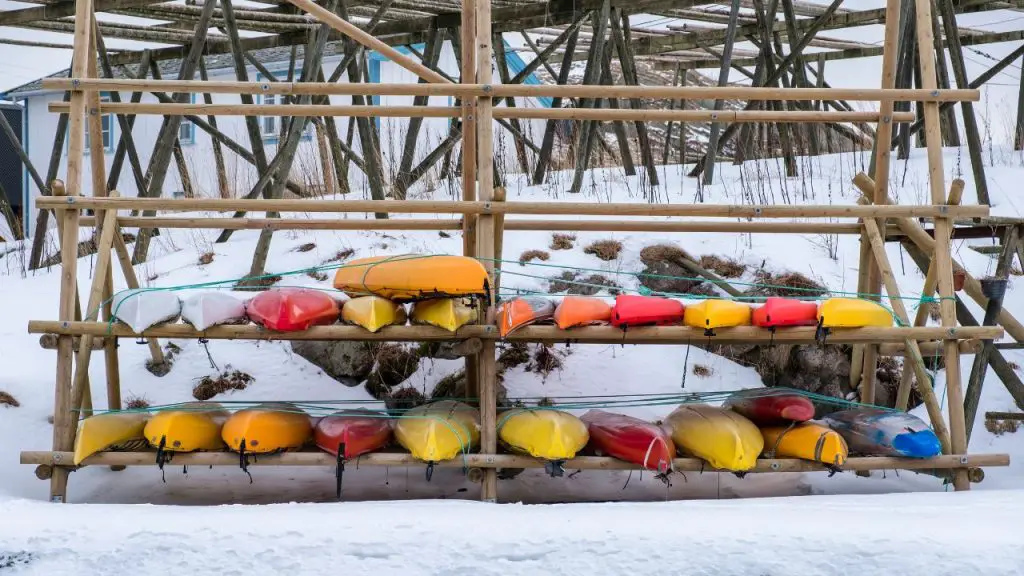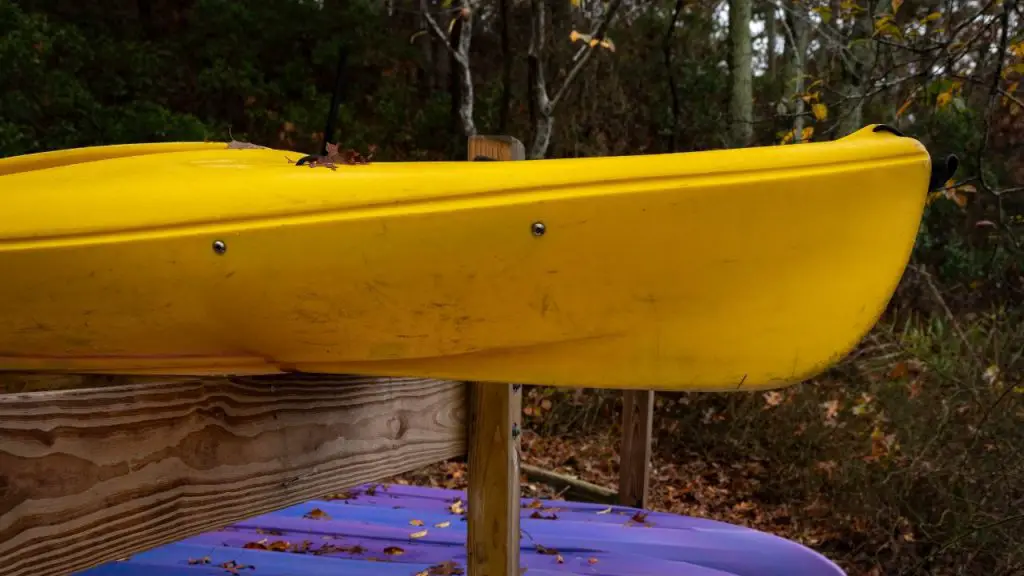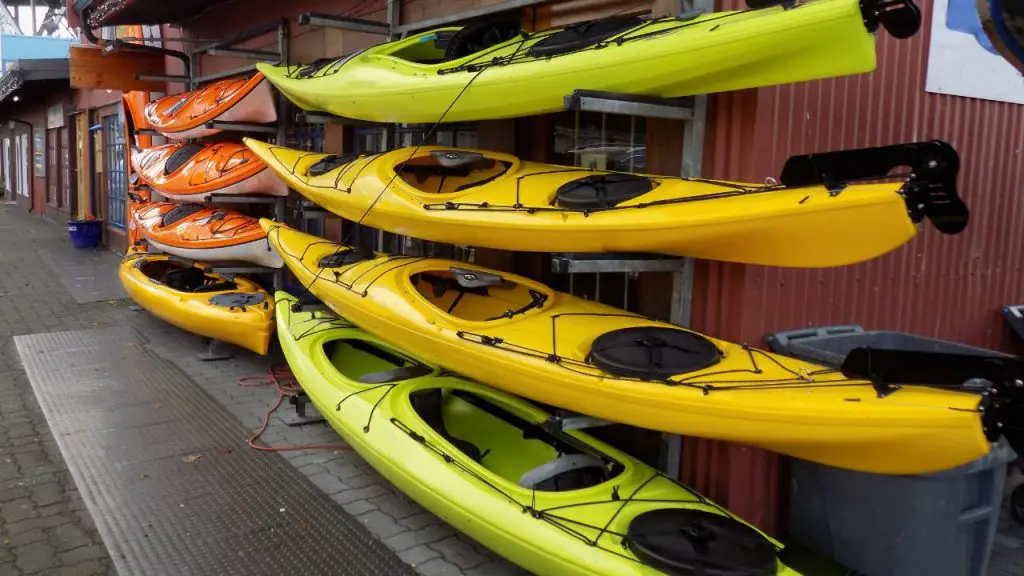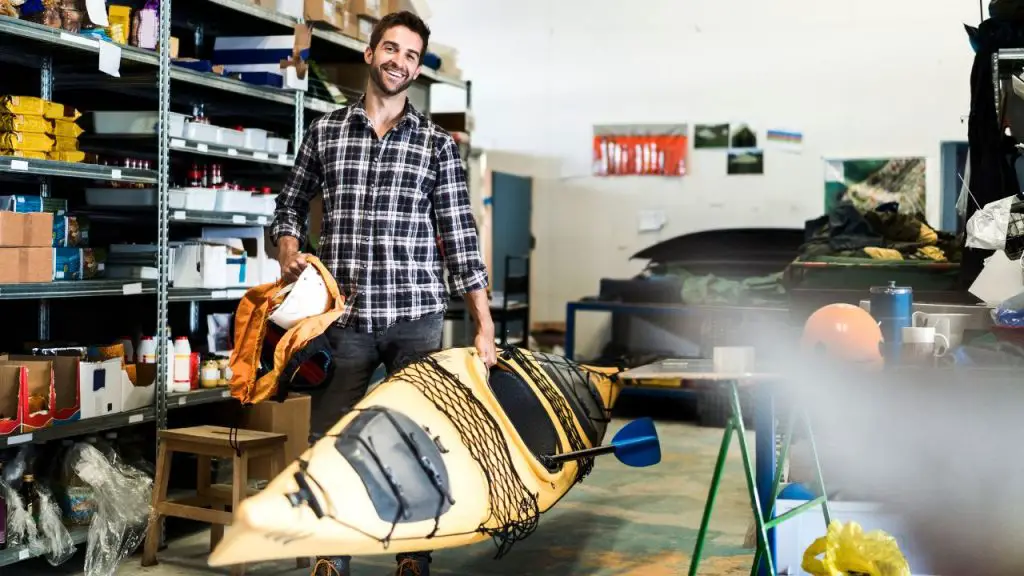Winter weather can be extremely harsh on different items left exposed outside. However, that does not mean you should squeeze everything indoors. But can kayaks be stored outside in winter?
Yes. You can leave your kayaks outdoors if protected from weather elements. But if you want to keep your kayak outside, consider a safe place and do it most effectively.
Find out more on how to keep your kayak outdoors during winter and when you need it, including tips for storing kayaks under such extreme weather conditions.
Table of Contents
Can Kayaks Be Stored Outside In Winter?

Yes. You can store your kayak outdoors during winter, provided it remains protected from the elements. Winter weather can potentially damage your kayak if left exposed. The snow can accumulate on the hull, causing dents or collapse of the boat.
But if you have a space in your garage or any shed, keep your kayak there. It will be safe from harsh weather elements and possible theft. Ensure the kayak is clean and covered when storing outside or inside.
Where to Store Your Kayak Outside
If you have limited space indoors, identify an appropriate location outdoors where your kayaks will remain safe throughout winter. The ideal spot should limit the kayak’s exposure to sunlight, moisture, temperature fluctuations, and other elements.
Avoid outdoor spaces where the kayak is consistently exposed to moisture from rain or snow. These can degrade the hull material, reducing the lifespan of your boat. Also, repeated freezing and thawing cause material stress that damages the kayak.

Consider safe outdoor spots such as under a deck, roof eaves, a strung-up tarp, or an open-air storage shed. You can extend the tarp above the hull instead of wrapping it around the boat. Also, avoid contact with the hull, which creates damp conditions for mold or fungal growth.
Most spots mentioned can protect your boat from moisture and direct sunlight. But you should cross-check to ensure rain or snow does not accumulate under any circumstance. If extending a tarp, ensure it won’t fill up with snore or rainwater to press down on the hull.
Classic Accessories StormPro 12 Ft Heavy-Duty Kayak/Canoe Cover
Pros and Cons of Storing Your Kayak Outside
Storing kayaks outdoors has its advantages and disadvantages, and all will depend on many factors. But, if possible, keep your kayaks indoors.
The first advantage is the ample space for storing multiple kayaks outside. You can keep your kayaks outdoors during winter regardless of the number and size. Usually, there is enough space outdoors to accommodate everything.
Another advantage of keeping your kayaks outdoors is accessibility. You can get your kayaks when you need them.

On the negative side, storing your kayaks outside may expose them to moisture and other extreme weather elements. These can potentially damage the kayak or reduce its structural integrity and lifespan.
Lastly, kayaks stored outside may be susceptible to theft if you don’t live in a safe neighborhood. An intruder can access the boat and carry it away unnoticed, though such cases are rare.
5 Ways to Store Kayak Outside In the Winter
Storing kayaks outdoors requires skills. First, you should never leave them directly on the ground. Using wall-mount racks and ground stands are the most common methods used by kayakers. But you can consider other ways discussed below.
On Stands and Covered With Tarps
Using stands and tarp extensions is the most straightforward approach to storing kayaks outdoors in the winter. They raise kayaks above the ground, and the boats are placed on top with the cockpit facing up.
However, consider flipping your kayaks upside down during winter to avoid snow and water from accumulating in them. It also prevents the tarp from tearing or ripping, where there is no support underneath, to the storage compartments.
The approach requires you to wrap your kayak in tarps to avoid direct moisture contact that can encourage mold or fungal growth.
You can store multiple kayaks on the stand and be covered with tarps. It is also suitable for all kayak types.
AA Products Kayak Storage Hanger Rack
Wall-Mounted Kayak Racks
Wall-mounted kayak racks on a fence or sidewall are also an effective way to keep your kayaks in winter. However, you should cover them from sun and moisture if the roof eave is not long enough, which is usually the case.
Different wall-mounted kayak racks exist. What you choose depends on the type and size of your boat. Generally, the kayak is fastened horizontally on the kayak racks once installed, with the cockpit facing away from the wall.
The size and number of kayaks you can keep outside using this approach depend on the wall-mount kayak rack you buy. Some can accommodate two or more boats, while others are designed for just one kayak.
Never install a wall-mount kayak rack on fences made with thin materials or drywalls. These do not have enough strength to support the kayaks. And if you do, the kayak racks will rip them apart under the weight of the kayak or snow.
Ensure the kayak racks are installed on the beams of your fence or framing on the sidewalls. Also, cover the boat to eliminate moisture contact and prevent snow from piling in the cockpit and storage compartments.
However, you should check your kayaks regularly to ensure they are safe, especially during winter. Clear any snore on the boat during these checks to avoid dents on the hull or warping.
Kayak Storage Hooks
Store Kayaks Under a Deck
Decks offer a safe spot for storing kayaks during winter. The space below your deck planks is usually big enough to keep two or more kayaks, depending on the size.
Storing kayaks under a deck during winter is worry-free since you don’t worry about snow accumulating on them. However, moisture problems may still exist as water drips from the deck planks.
You can use wall-mounted kayak racks or straps to raise your kayaks off the ground. Kayak stands are also ideal because you want your kayak to be suspended above the ground.
On a Kayak Rack
A kayak rack is an excellent solution for storing kayaks in the winter for kayakers on a low budget. You can use a DIY approach to make a kayak stand. Apart from the affordability, you don’t require a strong wall or fence like wall-mounted kayak racks. The ground bears all the kayak weight in this case.
You need 2×4 wood pieces and follow a T-shape design to make a kayak stand big enough for all your kayaks. This approach will save you money but requires more time and skills to pull out. If you are not a DIYer, you can buy ready-made kayak racks. These are easily assembled on-site.
Place the assembled kayak rack by the wall or fence and secure your kayaks on their decks. Once done, cover them with taros to keep off moisture.
As you anticipated, the size of kayak racks depends on the number of kayaks and their sizes. The bigger they are, the larger their kayak rack will be. So, budget for materials and space accordingly. You may need multiple tarps with strings or bungee straps to make them easy to secure.
Hold the entire structure down using sandbags, especially if you live in a windy area. You don’t want the wind to blow away your tarps or boats.
Building Your Own Covered Open-Air Shed
An open-air shed is the most effective method for storing multiple kayaks in winter. However, the construction process is time-consuming and demands a lot of resources. But if you pull it out, you will have a long-term kayak storage solution for keeping your kayaks safe during winter.
The design of an outdoor shed for storing the kayak varies. But the most common one is a double-deck rectangular design for storing two kayaks. A properly constructed open-air shed can be safer and more effective in keeping moisture and direct light from damaging your boats. Snow accumulation is also not a problem to worry about.
But if snow is a problem in your area during winter, consider a triangular or A-frame room. This design allows the snow to slide down. So, you don’t have to regularly check and remove them, as with the first design.
The size of an open-air kayak shed depends on the kayak size. A golden rule is to measure the length and width of your kayak and add an extra 12 inches to the dimensions. That makes it easy to set the kayaks in the set and helps you to determine the material you need for the construction.
Tips For Storing Your Kayak in the Winter
Factors to consider and tips when storing your kayak to avoid damage exist. These tips will ensure your boat remains safe and in good condition when the winter season ends, allowing you to resume kayaking without renovations:
1/ Determine the number of kayaks you want to store to know the amount of space required and the appropriate storage method
2/ Yard space and your Environment information help you to decide whether storing your kayaks outdoors is feasible or not.
3/ Clean your kayaks before storing them. Rinse the boat with fresh water to remove dirt, salt, or algae grime. You can also use a mild soap and water mix, but avoid reactive solvents or chemicals that can damage the kayak.
4/ Let the boat air out and dry before storing it away. Leaving it wet means mold and fungi will have a conducive environment to thrive.
5/ Store kayak up off the ground! Invest in affordable foam support or kayak stands to prevent warping and ensure an equal weight distribution.

6/ Store Your Kayak Accessories Inside. This may seem an afterthought, but it is necessary. Like human beings, critters also like staying indoors during winter. They will chew on the foam as they reside in the boat. Also, the accessories can grow mold when they become damp.
7/ Cover kayak somehow! You should protect your kayak from moisture and direct sunlight by all means because these can cause damage to your boat.
8/ Distribute weight evenly to avoid bends, dents, or cracks. Also, ensure no extra weight on the kayak by removing snow accumulation.
9/ Avoid pressure points by storing your kayaks on the sides. There will be less surface area exposed to continual pressure, which decreases the chances of warping.
10/ Offer theft protection by keeping your kayaks away from prying eyes or in an inaccessible spot. Make it challenging, if not impossible, for someone to take it away by locking it to a post, fence, or building.
FAQs
Is it OK to store a kayak outside?
Yes. You can store your kayak outside during winter, provided you protect it from moisture, direct sunlight, and theft. Security and safety of your kayak are the main factors to consider when keeping your boat outdoors.
Will kayaks crack in cold weather?
Yes. The plastic material used for making your kayak can crack in cold weather if you don’t store it properly. The continuous expansion and contraction of ice and snow on the kayak will eventually cause cracks.
Where do you store your kayak in the winter?
The most recommended place to store your kayak in the winter is indoors, probably in the garage. However, you can also keep it outdoors in a shed or other safe spots where moisture cannot damage your boat.
What is the best way to store a kayak?
The best way to store a kayak outdoors is to keep it off the ground on a stand or a designated rack and protected from moisture and direct sunlight. Ensure you clean the boat and let it air dry before storing it. Also, keep all accessories indoors.
How do I lock my kayak outside?
Most kayakers use a cable lock to secure their kayaks outside. These are inserted through the scupper holes or looped around the kayak. Use a lock and key or a different combination to protect it.
Can you store a kayak on sawhorses?
Yes. You can use 2×4 sawhorses as support bars when keeping your kayaks in the winter, but only if they are padded. Also, you should ensure the kayak is on its side. The weight of the hull is evenly distributed on the supports.
Conclusion
Winter comes with extreme weather conditions such as cold, snow, and moisture. These can damage your kayak if you don’t invest in a proper storage method outdoors.
First, ensure your kayak is off the ground and covered to protect it from moisture. Also, clean the kayak before storage and use the tips presented in this article for safe storage.
Thank you for reading this article at Windpaddle. We hope you found it informational and won’t mind sharing it with your fellow paddlers to educate them. Also, we invite you to explore the site for related content every kayaker should know.



